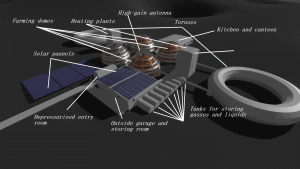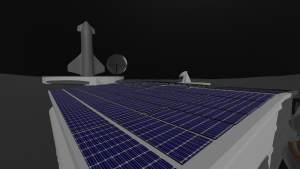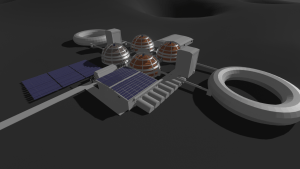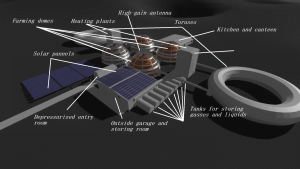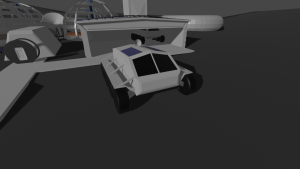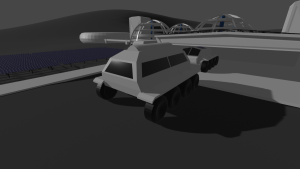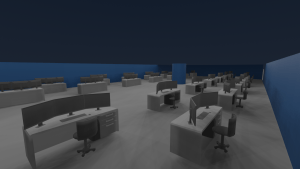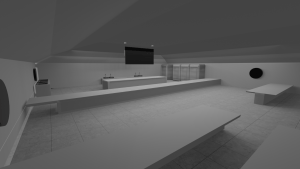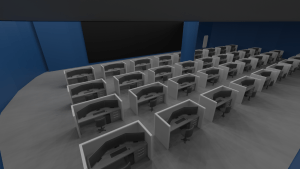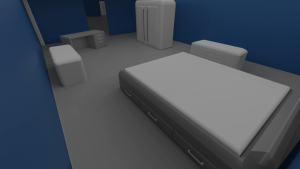Moon Camp Pioneers Gallery 2020-2021
In Moon Camp Pioneers each team’s mission is to 3D design a complete Moon Camp using Fusion 360. They also have to explain how they will use local resources, protect astronauts from the dangerous of space and describe the living and working facilities.
Team: RICA
“Ion Barbu” Theoretical Highschool Bucharest Romania 15
External viewer for 3d project
|
Project description
RICA proposes the development of unique technologies, a playground for testing adaptation to environmental conditions and also for innovations in the field of colonization of the moon. Arranged on the plateau of a crater at the South Pole, Shackleton, the RICA base offers researchers all the possibilities for a more than decent life. Divided into different sections that astronauts have, this is an effective way for the original scientific purpose. Offering all the needs of a being on Earth, our base has an infrastructural symphony developed in four domes that offers researchers a comfortable resting space, a greenhouse, where plants will develop, that ensures decent development, control center for the relationship with the Earth, entertainment spaces, but also other rooms including the doctor’s office. The possible settlement on the moon exploits all local resources, trying to become independent of the ones on Earth. The researchers studied the lunar regolith and concluded that it contains a relatively high concentration of the rare isotope Helium3, which could have a use in future nuclear fusion reactors on Earth, but also neodymium and lanthanum, used in technologies for speakers and smartphones, thus being able to reduce the construction costs by transporting them to the ground. One of the main targets of RICA’s base research is the study of lunar dust and the possibility of its properties to help the Earth fight climate change. We present the idea in the form of a concept, whose effects and possibility of existence still remain in question. |
|||
|
Where do you want to build your Moon Camp?
RICA is located near the South Pole of the Moon, in Shackleton crater, as this location is almost permanently lit during the day, representing a benefit for the exploitation of solar energy. At the same time, this factor is beneficial to a possible concept that would consist in the efficient exploitation of the channeled light from the peaks. We will try to capture as much as possible in a reactor that uses huge mirrors that catch light in a hot furnace by heating the lunar regolith to temperatures above 900°C, the temperature at which hydrogen or carbon, that we will initially transfer from Earth, can remove oxygen from its minerals and form a compound with hydrogen molecules to form water. At the same time, the location chosen is a decisive factor, as the South Pole has significant amounts of ice-filled craters that can be an important source of water. How do you plan to build your Moon Camp? Describe the techniques and materials you would use.
The base aims at a structural longevity of a few decades or more. Thus, the construction of our project is based on robots equipped with 3D printers that use the rules obtained after excavation. There is an underground space but also an above-ground one. The basic materials have an increased resistance, such as aluminum alloys. The greenhouses benefit from a hard glass roof that will give them a transparency for light but also a concrete resistance. For normal protection we will use polyethylene and carbon kevlar in construction. The system includes solar panels. The toruses of the power plant we benefit from will be built of thermo-conductive materials and through the sun’s rays with thermal energy, the water found in them will be heated and will be circulated through the thermo-electric power plants. The chosen design offers an increased functionality, reliably connecting all the base units that benefit from 4 elevators between the floors of the 4 domes: for housing, command-control, storage and utilities. The environment on the Moon is very dangerous for the astronauts. Explain how your Moon Camp will protect them.
RICA is located at the Southern Pole of the moon, a factor that implies a minimum thermal amplitude. The essential part of the base is located underground, which saves us from the major risk of meteorites, radiation and extreme temperatures and in case of emergency the situation can be controlled underground. The base has a rocket that is intended for supply in case of emergency, which we can use for boarding in special cases. Attempts are being made to create a computer system to prevent meteorites and hazards. At the entrance to RICA there is a space for disinfection of costumes that may have dangerous radiation. It is possible that they have a heavy material inside them that prevents the entry of radiation, also having a gravitational purpose. Explain how your Moon Camp will provide the astronauts with:
|
|||
|
Water
|
Food
|
Electricity
|
Air
|
|
The main water source of the base is the ice extracted with the help of rovers equipped with drills from the craters at the South Pole. It will be stored in detachable storage units. We implement the exploitation of solar thermal energy inside the crater, with the help of which the ice will turn into steam. The lunar regolith includes silica and metal oxides, which make it an average of 43% oxygen by mass. Through the technique of mirrors previously detailed, we can link oxygen removed from the minerals with hydrogen or carbon to result in water. |
The food is based on four hydroponic greenhouses. Astronauts could try a new concept of plant growth, which is based on water and white and red LEDs that can change their vitamin and mineral composition. As a closed ecosystem, plants would recycle organic waste and turn carbon dioxide into oxygen to breathe. We will require the selection from Earth for a diet that involves crops that grow well indoors and are packed with nutrients that degrade the least in storage – vitamins C1, K and potassium. We try to grow worms for protein and water the plants with filtered urine. |
The base has photovoltaic panels, which harnesses solar energy. Vapors ,provided by the heated water from the torusses, will drive a propeller connected to an electric motor, resulting in a mass of electricity. The base tries to streamline and conserve all the energy it has, such as the case of heating ice in craters. Condensed water, through a processing and division plant in hydrogen and oxygen molecules, a process influenced by solar electricity, will be stored in units of propulsion or channeled through fuel cells to provide energy. Even in the gym, treadmills are connected to a system of electricity . |
RICA benefits from air obtained by electrolysis and metalysis. We electrolyze the water, or we metalyse the lunar regolith. The electrolysis process has been approached before, so we will develop the metalysis in more detail. Calcium chloride is added to regolith – the electrolyte – and the mixture is heated to about 950°C. Then an electric current is applied. It extracts oxygen and migrates the salt to an anode, where it can be removed. The metal left behind is usable as construction material. The oxygen obtained must be mixed with nitrogen, which we bring from Earth, to form breathable air. |
|
Explain what would be the main purpose of your Moon Camp (for example: commercial, scientific, and/or tourist purposes).
Our settlement has a scientific purpose. One of the goals of the project is the study of the lunar regolith. But in order to combat global warming, we can intervene with sun shadows in the orbit of our world that could reduce the amount of energy we receive from the Sun. Those shadows are clouds of lunar dust transported from the mines on the moon and thrown into strategic places in orbit. But there are also disadvantages such as more light at night, but we categorize it as a desperate measure. The rocket fuel that is more advantageous on the moon, it no longer has to go through the massive gravitational field of the Earth. Extracting ice on the Moon and launching an orbiting monthly “gas station”. The station would then turn it into hydrogen-oxygen rocket fuel and transfer it to long-distance spacecraft, such as those bound for Mars. |
|||
|
Describe a day on the Moon for your Moon Camp astronaut crew.
RICA advances conceptual living on the moon to a possible reality. Astronauts can adapt to unfavorable environmental conditions by trying to discover new technologies for the development of life and humanity. Living is as simple as possible: survival and development from 0. From minimal resources we will propose high-level scientific research to adapt the mind and body to living in a much smaller and totally unknown space. Those on board the base, in number of approx. 60 people, will have the activity structured in shifts: night shift and day shift. This team consists of researchers and engineers who will develop their instinct to integrate into a new environment. They will start their day with a nutritious breakfast, which will stabilize their digestive rhythm and give them an energy boost for the rest of the day. Those inside will be served a buffet meal, and those on expeditions, outside the base, will be offered non-perishable food and easy to store, and can even take some food supplements to help. Next, the astronauts will be assigned different tasks in groups: command and control, research, engineering and technical support, botany, mining, storage and exploration. They will have an 8-hour work schedule, with breaks of 30 minutes at 3-hour intervals. The doctors present at the base will carefully check the evolution of RICA members, managing the situation in the best possible way. People will carry out their work carefully, checking stability and safety, sending any risk factor back to the base through the protocol. Those in command and control will permanently transmit reports to the ground but also to all ships and satellites that fall within the coverage of the base. Rica has a fitness room that maintains the muscles of the members, also contributing through an energetic contribution to the base resources. Each person benefits from their own room, equipped with all the comfort elements as on the mother planet. RICA aspires to be a step towards evolution by interconnecting the cosmos with the human being. |
|||


